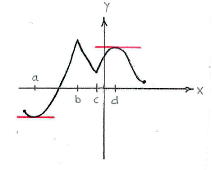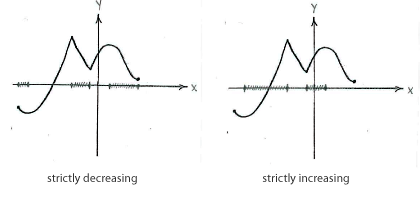Solution 1.3:1d
From Förberedande kurs i matematik 2
(Difference between revisions)
m |
|||
| (3 intermediate revisions not shown.) | |||
| Line 1: | Line 1: | ||
| - | + | The function has critical points at the points <math>x=a</math> and <math>x=d</math>, (see figure below), i.e. the derivatives are equal to zero, but note that <math>x=b</math> and <math>x=c</math> are not critical points (the derivative is not even defined at these points). | |
| - | < | + | |
| - | + | ||
| - | + | ||
| - | < | + | |
| - | + | ||
| - | [[ | + | [[Image:1_3_1_d1.gif|center]] |
| - | [[ | + | |
| + | The function has local minimum points at <math>x=a</math>, <math>x=c</math> and the right endpoint of the interval of definition and the local maximum points at the left endpoint, <math>x=b</math>, and <math>x=d</math>. Of these, <math>x=b</math> is the global maximum and <math>x=a</math> is the global minimum. | ||
| + | |||
| + | Between the local extreme points, the function is strictly increasing or decreasing. | ||
| + | |||
| + | [[Image:1_3_1_d2.gif|center]] | ||
Current revision
The function has critical points at the points \displaystyle x=a and \displaystyle x=d, (see figure below), i.e. the derivatives are equal to zero, but note that \displaystyle x=b and \displaystyle x=c are not critical points (the derivative is not even defined at these points).
The function has local minimum points at \displaystyle x=a, \displaystyle x=c and the right endpoint of the interval of definition and the local maximum points at the left endpoint, \displaystyle x=b, and \displaystyle x=d. Of these, \displaystyle x=b is the global maximum and \displaystyle x=a is the global minimum.
Between the local extreme points, the function is strictly increasing or decreasing.


